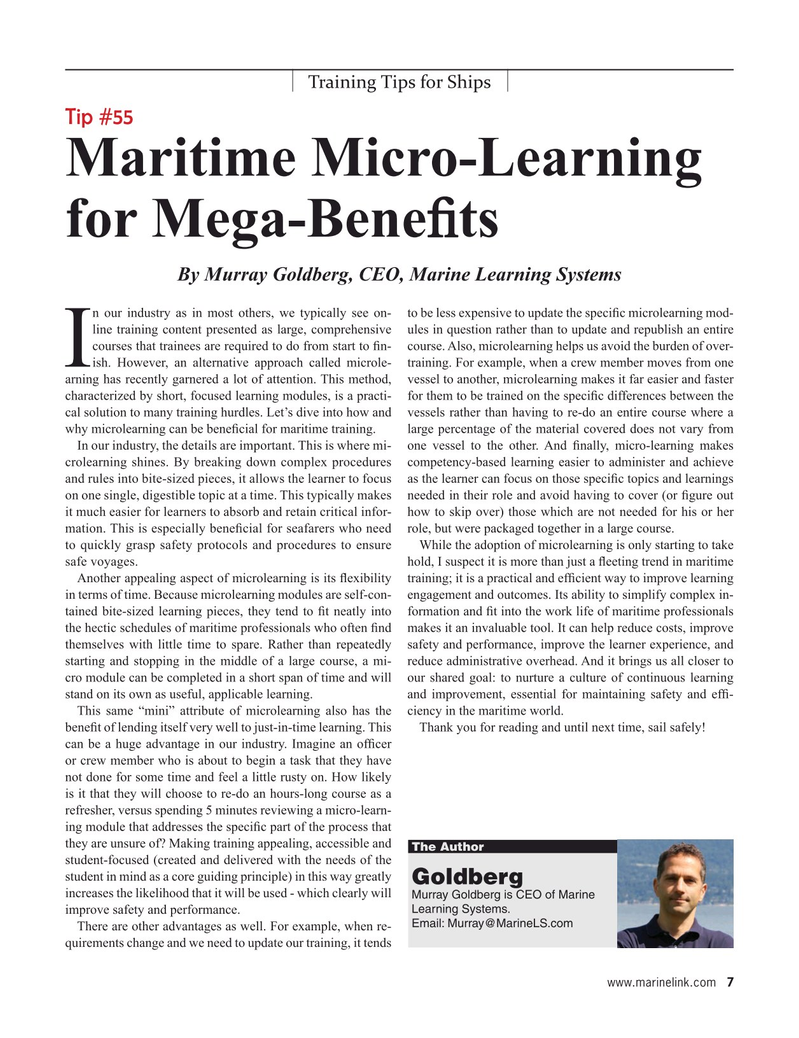
Page 7: of Maritime Reporter Magazine (January 2024)
Read this page in Pdf, Flash or Html5 edition of January 2024 Maritime Reporter Magazine
Training Tips for Ships
Tip #55
Maritime Micro-Learning for Mega-Bene? ts
By Murray Goldberg, CEO, Marine Learning Systems n our industry as in most others, we typically see on- to be less expensive to update the speci? c microlearning mod- line training content presented as large, comprehensive ules in question rather than to update and republish an entire courses that trainees are required to do from start to ? n- course. Also, microlearning helps us avoid the burden of over-
Iish. However, an alternative approach called microle- training. For example, when a crew member moves from one arning has recently garnered a lot of attention. This method, vessel to another, microlearning makes it far easier and faster characterized by short, focused learning modules, is a practi- for them to be trained on the speci? c differences between the cal solution to many training hurdles. Let’s dive into how and vessels rather than having to re-do an entire course where a why microlearning can be bene? cial for maritime training. large percentage of the material covered does not vary from
In our industry, the details are important. This is where mi- one vessel to the other. And ? nally, micro-learning makes crolearning shines. By breaking down complex procedures competency-based learning easier to administer and achieve and rules into bite-sized pieces, it allows the learner to focus as the learner can focus on those speci? c topics and learnings on one single, digestible topic at a time. This typically makes needed in their role and avoid having to cover (or ? gure out it much easier for learners to absorb and retain critical infor- how to skip over) those which are not needed for his or her mation. This is especially bene? cial for seafarers who need role, but were packaged together in a large course.
to quickly grasp safety protocols and procedures to ensure While the adoption of microlearning is only starting to take safe voyages. hold, I suspect it is more than just a ? eeting trend in maritime
Another appealing aspect of microlearning is its ? exibility training; it is a practical and ef? cient way to improve learning in terms of time. Because microlearning modules are self-con- engagement and outcomes. Its ability to simplify complex in- tained bite-sized learning pieces, they tend to ? t neatly into formation and ? t into the work life of maritime professionals the hectic schedules of maritime professionals who often ? nd makes it an invaluable tool. It can help reduce costs, improve themselves with little time to spare. Rather than repeatedly safety and performance, improve the learner experience, and starting and stopping in the middle of a large course, a mi- reduce administrative overhead. And it brings us all closer to cro module can be completed in a short span of time and will our shared goal: to nurture a culture of continuous learning stand on its own as useful, applicable learning. and improvement, essential for maintaining safety and ef? -
This same “mini” attribute of microlearning also has the ciency in the maritime world.
bene? t of lending itself very well to just-in-time learning. This Thank you for reading and until next time, sail safely!
can be a huge advantage in our industry. Imagine an of? cer or crew member who is about to begin a task that they have not done for some time and feel a little rusty on. How likely is it that they will choose to re-do an hours-long course as a refresher, versus spending 5 minutes reviewing a micro-learn- ing module that addresses the speci? c part of the process that they are unsure of? Making training appealing, accessible and
The Author student-focused (created and delivered with the needs of the student in mind as a core guiding principle) in this way greatly
Goldberg increases the likelihood that it will be used - which clearly will
Murray Goldberg is CEO of Marine
Learning Systems. improve safety and performance.
Email: [email protected]
There are other advantages as well. For example, when re- quirements change and we need to update our training, it tends www.marinelink.com 7
MR #1 (1-17).indd 7 1/8/2024 9:13:50 AM

 6
6

 8
8
